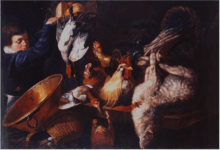Giacomo Legi
Giacomo Legi (alternative names: Giacomo Liegi and Jacques Legi) (±1600, probably in Liège or Prince-Bishopric of Liège, possibly in Antwerp - between 1640 and 1645, Milan) was a Baroque painter of Flemish descent who was active principally in Italy during the first half of the 17th century.
Biography

Little is known about Legi’s early life. His original name is not known with certainty. It is believed that his Italian name is derived from the French word Liège which may refer to the city Liège or the Prince-Bishopric of Liège (Liegi in Italian), in present-day Belgium, where he may have been born.[1] Antwerp has also been suggested as a possible place of birth.[2]
He moved to Genoa to work as an apprentice in the workshop of his brother-in-law Jan Roos, a Flemish painter who had made a name for himself in Genoa and had married a local woman. Jan Roos specialized in still lifes and market scenes.
Struck by an illness he moved for treatment to Milan, where he died some time between 1640 and 1645.
Work
Inspired by his teacher Jan Roos, Legi became a master of the still life and of genre paintings. Roos and Legi played an important role in the development of the baroque still life in Italy.[3]
During his stay in Genoa, he collaborated with the local painter Domenico Fiasella.[4]
Selected works
- Market, Oil on canvas, 150x186 cm, Galleria di Palazzo Bianco, Genoa[5]
- Kitchen, Oil on canvas, 150x186 cm, Palazzo Tursi, Genoa
- Pantry with live and dead animals with a young man, Oil on canvas, 99x147 cm, Musée des Beaux-Arts de Bordeaux, Bordeaux
- Pantry with animals, hanging ham, pans and cook, Oil on canvas, 112x142 cm, Musée des Beaux-Arts de Bordeaux, Bordeaux
- Pantry with animals, fruit, vegetables and a male character, Oil on canvas, Private Collection, Genoa
- The Fortune Teller, Oil on canvas, in collaboration with Domenico Fiasella, Albergo dei Poveri, Genoa
- Kitchen interior, oil on canvas, private collection[6]
Notes
- ↑ Le Vite De Pittori Scultori, et Architetti Genovesi, e de' Forastieri, che in Genoua operarono Con alcuni Ritratti de gli stessi; by Raffaele Soprani e Giovanni Nicolò Cavana, Google books.
- ↑ Giacomo Legi at the Netherlands Institute for Art History (Dutch)
- ↑ Giacomo Legi (Liège 1600 – 1640 Milan)
- ↑ Abecedario pittorico; by Pellegrino Antonio Orlandi e Pietro Guarienti] Google books
- ↑ ROOM 18 Rubens, Van Dyck and Jan Roos museidigenova.it
- ↑ La letteratura ligure in genovese e nei dialetti locali Volume III.
References
- Pellegrino Antonio Orlandi, Pietro Guarienti, Abecedario pittorico, Venezia.
- Raffaele Soprani, Giovanni Nicolò Cavana, Le Vite De Pittori Scoltori, Et Architetti Genovesi, E de' Forastieri, che in Genoua operarono Con alcuni Ritratti de gli stessi, Genova
- Fiorenzo Toso, La letteratura ligure in genovese e nei dialetti locali, vol. 1, Le Mani, Recco 2009.